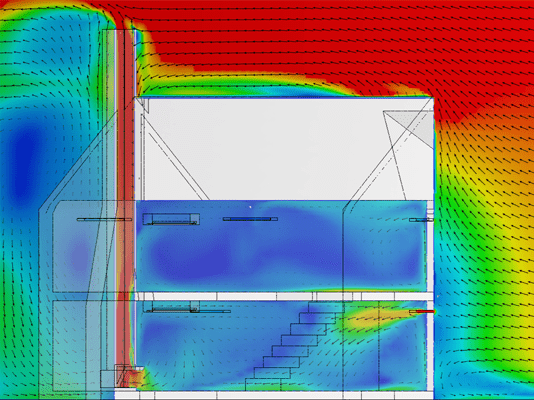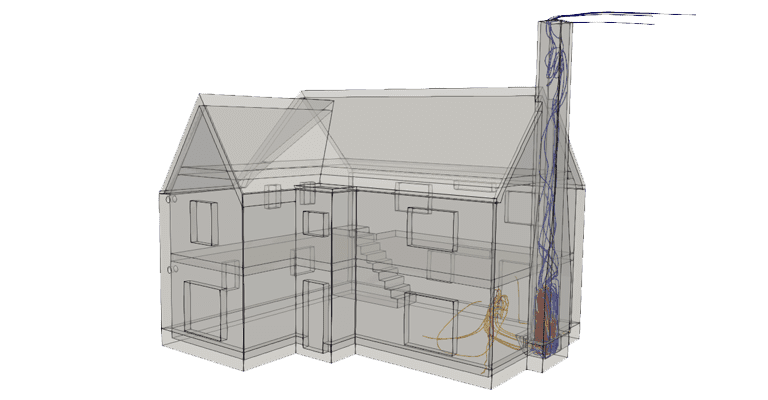When designing natural or passive ventilation systems, both stack ventilation and Bernoulli’s principle, or Bernoulli effect, can be applied. Generally, it is even the case that if a building is strategically built using either one of the aforementioned phenomena, the other will also occur. In short, designing for these effects requires a large difference in height between air inlets and outlets. The bigger the difference, the better. But what is passive ventilation? What are these effects? And what are the benefits of employing passive methods over mechanical ventilation system designs? In this article, we will answer these questions.
What Is Passive Ventilation?
Passive or natural ventilation supplies and removes air from indoor spaces without the assistance of mechanical systems. Passive ventilation instead relies on pressure differences of natural forces to facilitate airflow. When used in a system, this type of ventilation works to regulate temperature through inlets and outlets (i.e., windows, vents, etc.) in three methods:
- Wind-driven ventilation: Driven by pressure differences between the internal and external air around the building

Passive ventilation being employed using wind through window installations - Buoyancy-driven ventilation: Driven by temperature differences between the internal and external environments (i.e., stack ventilation)

- Night-cooling ventilation: Driven by the release of heat absorbed by the building’s thermal mass during the daytime

In this article, we now focus on two effects that exist within these ventilation methods; stack ventilation and Bernoulli’s principle.
What is Stack Ventilation
After wind-driven ventilation, which is chiefly facilitated by the opening and closing of windows, stack ventilation is the most regularly used form of passive ventilation. Stack ventilation, along with Bernoulli’s principle, can be remarkably effective and inexpensive to achieve within a building design. It is important to consider buoyancy-driven strategies like stack ventilation in addition to wind-driven strategies when considering passive ventilation tactics, because natural forces such as wind usually slow down at night and can, therefore, make wind-driven strategies less effective and inefficient.

Stack ventilation (also known as stack effect or chimney effect) creates airflow using the natural force that emerges from changes in air pressure, temperature, and density levels between corresponding internal and external environments. The relevant variables that create this environmental effect are thermal contrasts paired with the height of the given structure. Airflow through a chimney is one example of stack effect due to its inclusion of the two main variables at play; height and temperature difference. You can learn more about stack effect in this case study.
Download our ‘Wind Engineering’ white paper to learn about building design, wind loading implications, pedestrian wind comfort, natural and mechanical ventilation, pollution mitigation, and more!
Solar radiation can be used to enhance stack ventilation in tall, open indoor spaces. By allowing solar radiation in a space (by using equator-facing window glazing for example), you can heat up internal surfaces to increase the room temperature, which then expedites stack ventilation between the top and bottom inlet openings.
How Are Stack Ventilation and Bernoulli’s Principle Comparable?
Even though the two phenomena are both considered buoyancy-driven ventilation effects, the main difference lies where the pressure difference is found. Lower air pressures at higher heights can passively pull air through a building. Stack ventilation uses temperature differences to move air. Hot air rises because of its low-pressure characteristics.
Bernoulli’s principle uses wind speed differences to move air, so it can also fall into the wind-driven ventilation category. It is a general principle of fluid dynamics that the faster air moves, the lower its pressure. Outside air that is further away from the ground is less obstructed, so it moves faster than air closer to the ground. The higher air, therefore, has lower pressure. This lower pressure can help “suck” fresh air through the building. A building’s surroundings can greatly affect this strategy, as more or less obstruction could be caused depending on whether the building is in a quieter or more built-up environment.

Natural Ventilation Advantages
Most engineers would agree that Bernoulli’s principle, or the Bernoulli effect, is advantageous in many design scenarios, as it harnesses the effectiveness of wind ventilation and buoyancy-driven ventilation. The advantage of stack ventilation over Bernoulli’s principle is that it does not rely on the wind; it continues to be in effect on non-windy days (when it may be most needed). In many cases, designing for one passive method of ventilation effectively designs for both. Specific approaches can be exercised to simply emphasize one or the other. For example, a chimney optimizes for stack ventilation, while wind scoops optimize for Bernoulli’s principle.
Conclusion
A successful passive ventilation system will achieve high levels of thermal comfort and optimal fresh air for the respective indoor space by relying on these strategies while demanding little or no energy use for active HVAC cooling and ventilation processes. Stack ventilation and the Bernoulli effect can be combined with cross-ventilation and take advantage of multiple horizontal and vertical air pathways to achieve maximum indoor air quality and thermal comfort. In conclusion, engineers should aim to employ both effects, but remember stack ventilation does not rely on wind force and can generally be considered more reliable because of this.
For more ventilation resources from SimScale, check out these blogs:
- Mechanical Ventilation Simulation and Optimization with SAV Systems
- Stack Effect & Ventilation System Design
- Industrial Ventilation: Testing Exhaust Fume Extraction System Designs



